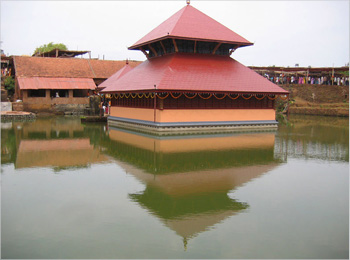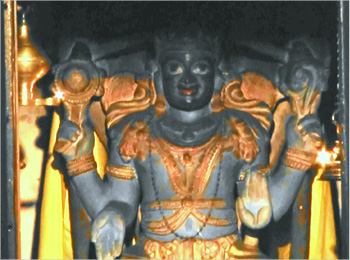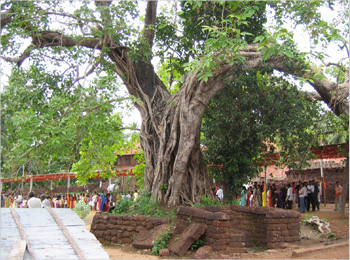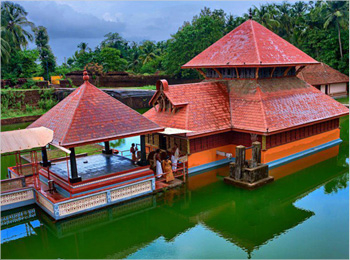- Shiva
Ananthapura Lake Temple
- Kasargod, kerala
- View on map
- Tell us about this temple
Overview
Kasaragod is one of the districts in the northern tip of Kerala. Kasargod is surrounded by Kannur district in the south, Mangalore in the north, Western Ghats in the west and Arabain Sea in the east. Like other districts of Kerala, Kasaragod district too has a high literacy rate, around 85.17%. The district has got mixed culture and is highly influenced by the neighboring states. The Malayalam spoken here has influences from Tulu, Kannada Urdu, Konkani etc. Kasaragod has enchanting beauty and is a land of historical importance. The district is home to the most fascinating forts, rivers, hills and beautiful beaches. The fort at Bekal is the largest and best preserved fort in the state. Kasaragod is world renowned for its coir and handloom industries. Fishing is a prime source of livelihood. Kasaragod is known as the land of gods, forts, rivers, hills and beautiful beaches. The fort at Bekal is the largest and best preserved in the State. Kasaragod displays a variety of styles in temple architecture - the unique style of the Madhur Mahaganapathy Temple, the typical Kerala style of the historic Malik Deenar Great Juma Masjid and so on speak volumes about the rich cultural heritage of the region. Spectacular pageants of Theyyam, Yakshagana, Kumbla (buffalo race), Poorakkali, Kolkali etc. enchant visitors.
About the temple

The Ananthapura Lake Temple is built in the middle of a lake in the little village of Ananthapura, Kasaragod District of Kerala, South India, at around 6 km from Kumble. This is the only lake temple in Kerala and is believed to be the original seat (Moolasthanam) of Ananthapadmanabha Swami (Padmanabhaswamy temple) Thiruvananthapuram. Legend has it that this is the original site where Ananthapadmanabha settled down. The lake in which the Sanctum Sanctorum is built measures about 2 acres (302 feet square). An interesting spot to keep in mind while visiting the temple is a cave to the right corner of the lake. According to the local legend, the deity Anantha Padmanabha chose to go all the way to Thiruvananthapuram through that cave. Both places retain similar names, in spite of being on either end of the region. The past of the temple is still obscure except for some myths. It was at this place where Divakara Muni Vilwamangalam, the great Tulu Brahmin sage, did penance and performed poojas. Legend has it that one day Lord Narayana appeared before him as a child. The boy’s face was glowing with radiance and this overwhelmed the sage. He became anxious and asked who he was. The boy replied that he had no father no mother and none at home. Vilwamangalam felt pity for the boy and allowed him to stay there. The boy proposed a condition that whenever he feels humiliated he will leave the place at once. He served the sage for some time. But soon his juvenile pranks became intolerable for the sage and he reacted violently. Humiliated the boy disappeared from there after proclaiming that if Vilwamangalam wants to see him he would have to go to Ananthankat, the forest of serpent god Anantha. Vilwamangalam soon realized that the boy was none but the lord himself and he had great repentance. He found a cave at the place where the boy disappeared and he proceeded further into the cave in search of the boy. He reached the sea and proceeded further toward the south and at last he reached a woody area near the sea. Vilwamangalam saw the child who soon disappeared into huge illippa tree (Indian butter tree or Mahua tree). Immediately the tree fell down and assumed the shape of Lord Vishnu lying on a thousand-hooded serpent. The temple also has yet another interesting tale to tell – the story of the guardian crocodile. From very ancient times, one crocodile has been seen there. Though devotees used to take bath in the tank there is no instance of it harming anyone. Babia is the name by which this guardian is known to the world. It is the local guardian and the messenger of the temple. The only food that Babia takes is the offerings of the devotees. Usually it is a special gruel made of rice and molasses. After the worship, the feed offered by devotees is given to Babia at noon. Temple authorities claim that Babia is a vegetarian and has never harmed anyone including the fishes in the pond. There is an interesting local legend that narrates the entire story behind the guardian crocodile. Once Sree Vilvamangalathu Swami, devotee of Lord Vishnu, was doing penance for his favorite lord. While he was in his prayers, Lord Krishna in the form of a little boy appeared and started disturbing him. Being annoyed by the by the behaviour of this child, the saint pushed Lord Krishna aside with his left hand. The boy immediately disappeared into a nearby cave and the truth dawned on the saint. The crevice into which Krishna is said to have disappeared is still there. The crocodile guards the entrance and the shrine. In 1945, when the British soldiers were stationed there, one soldier shot dead the crocodile. To the surprise of everyone the soldier died within few days by a snake-bite. People believe it to be revenge by the serpent god Anantha. Soon another crocodile appeared in the tank and even now if one is fortunate they can see it. The legend goes that there is only one crocodile in the lake at a time. When one crocodile dies, another one appears in the lake. The devotees pay great respect to this crocodile.
Architectural Style

The temple is unique in its structural aspects for it is erected in the middle of an impressive lake of 302 feet. The lake is gifted with a perennial supply of pure spring water. We can find the ruins of temples all-round the lake which stands testimony to the fact that it was part of a great temple complex. The sreekovil (sanctum sanctorum), namaskara-mandapam, thitappalli, and shrines of Jala-Durga and the entrance of the cave are located in the lake. The namaskara mandapam is connected to the eastern rock by a foot-bridge which is the only passage to the sreekovil. The principal deity is Lord Vishnu. One of the key features of the temple is that the original idols in the sanctum sanctorum were not made of metal or stone, but of a rare combination of more than 70 medicinal materials called `kadu-sharkara-yogam.' These idols were replaced by panchaloha metals in 1972. They were donated by Kaanchi Kaamakoti Mathaadhipathi His Holiness Jayendra Saraswathy Thiruvatikal. Efforts are going on now to reinstall the idols made with `kadu-sharkara-yogam.' The Lord Vishnu idol is in a sitting pose over a five-hooded serpent king Lord Anantha. The lake temple is open to all visitors regardless of caste or creed. The District Tourism Promotion Council has plans to preserve the temple and its surroundings for its uniqueness. The temple has an excellent collection of wood carvings on the ceilings of the mandapam. These carvings depict the incidents taken from the stories of dasaavatharam (the ten incarnations of Lord Vishnu). Some of them are painted. The Nava-grahas (nine planets) are painted at the muktha-mandapam. On either side of the sreekovil dwaara-palakas (jaya and vijaya) are beautifully carved in wood. The temple is open to all regardless of religion or cast. The nearest major railway station to Ananthapura Lake Temple is Kasaragod railway station which is about 12 km from here. There is also a railway station at Kumbala. Karipur International Airport, Kozhikode is the nearest airport which is about 200 km from here. To reach there by road one has to take a deviation from Naayakkaapp (5k m from Kumbala) on the Kumbala-Badiyatukka road.
About the Deity

This is the most accepted version regarding the consecration of the Temple and relates to the famous Namboodiri Brahmin sage by name Vilvamangalathu Swamiyar. Three Vilvamangalattu Swamiyars have lived during different times, according to some. Vilvamanagalam I dates to the 9th century and Vilvamangalam III to the, 16th century( about 1585 AD) with Vilvamangalam II coming in between. Even if the 9th Century saint is accepted as the Central figure in this Sthala Puranam, anachronism is glaringly obvious. The story basically runs on the same lines as that of Duvaraka Muni, deviating only at certain points. The location is in North Malabar and the Kasargode Sree Ananthapuram Temple featured in both. Here the child does not stay with the swamiyar but would faithfully appear every day during the Puja time of the sage. The Salagrama episode is the same and here the saint shows his annoyance by pushing back the little one with the back of the hand. (To this day it is deemed inauspicious to push someone away, with the back of the hand). The next difference in the story surfaces a little later on. It is said that the Sage ran after the child but soon lost track of him. The sound of the bells on the anklets adorning those little feet and on the waistband guided him for some more time, then they too ceased. The Sage wandered from place to place, consecrating many renowned temples of today on the way and getting many divine experience. He moved from North Kerala to the South Kerala in his ceaseless quest of the divine Child and Ananthankatu where he would find him. One evening he rested under a tree, physically and mentally weary. From the opposite side where stood the hut of a Pulaya, he heard the raise voice of an angry Pulayi threatening her baby who would not stop crying, that she would throw it into Ananthakatu if it did not stop wailing. The joyous Sages rushed to the hut and in answer to his question, the woman pointed to the near-by forest which was the destination of his long search. After blessing her and taking a single lighted wick from her to aid his progress into darkness in search of the Supreme Light, the Swamiyar entered the forest. Before long, the dearly familiar sound of the waistbells and anklets could be heard. In the pre-dawn hours, suddenly an lluppa tree crashed down with a mighty sound before him, and a great radiance manifested. On reaching the spot he got the Darsanam or Vision of God as Sree Padmanabha Swamy reclining on the serpent chief Ananta. The extent of this form and the subsequent reduction in size in response to the Sage’s prayers are the same as in the story about Divakara Muni. Having nothing else to offer to the Lord, the Swamiyar took a small unripe mango from a nearby, tree and placing it in a dry coconut shell submitted the same to the Lord in an overflow of emotion. The offering of a salted mango in the coconut shell which is reported to be the same one used by the Swamiyar though now covered with gold and gem studded, continues as an important daily Nivedyam to this day. In this connection it merits mention that the wood of this Iluppa tree is believed to have been utilized to carve the figure oh Sree Padmanabha Swamy and till the time of Marthanda Varma the Great, the Idol is seen to be of this wood. The Naduvil, Madhom, Pushpanjali Swamiyar’s, premises lying to the west of Sree Padmanabha Swamy Temple also contains a Sree Krishna Temple which is believed to have been consecrated on the Villvamangalathu Swamiyar’s, Samadhi. This adds much weight to the sage’s link with the Temple. The necessary presence of a Namboodiri Brahmin who has embraced, Sanyasam and has become a Sanyasi, renunciate) of a monastic order and who is known as the Pushpanjali Swamiyar, since he performs the daily Pushpanjali (workship with flowers) and holds an important place in Temple affairs, as well as the fact that the traditional Tantri family — the supreme arbitrator in Temple matters – is also of Namboodiri stock – corroborate the ongoing Namboodiri tradition in the Sree Padmanabha Swamy Temple. The Sree Anantapuram Temple in kasargode is related to both Divakara Muni and Vilvamangalathu Swamiyar. Kasargode which is today a part of Kerala was once in Tulu country. As such a trend of thought strongly prevails that both these sages were in reality one individual. As per these accounts the time slot detailed dates back to some centuries only whereas this Temple has gained repeated mention from the time of the undated Puranas and ancient literature. Hence the presence of the anachronism with regard to the popular belief connected with the Sthala Puranam. The one explanation seems to be that while it is an established truth that the Sree Padmanabha Swamy Temple exists enveloped in timelessness, it is possible that this great shrine too faced reversals of fortune at certain phases of evolution necessitating its rediscovery and consequent re-consecration, while the Divinity in the Saguna aspect (that which has a form) continued unaffected. The physical constructions however have undergone alterations and structural renovations at different stages of the spiritually significant march of the Temple down the corridors of ages to emerge on the calendar of centuries with the brilliance of multitudinous suns. The idol of Sri Anantha Padmanabha Swamy and other idols are neither metal or stone, but made of a rare combination of more than 108 materials called Kadu-Sarkara-Yogam. Today this rare combination is known only to an aged artisan, Sri Subrahmanyan Achary and family of Vaikom.
Legends And Stories
Since time immemorial Kasaragod has been well-known to the world outside. But very few studies and researches are done regarding the history of Kasaragod. That few studies hail the diversity of this place. Being an important trade centre the place has lured travellers from different parts of the world especially the Arabs and Europeans. The pamphlets and descriptions written by these adventurous travellers about the cultural and economic diversity of Kasaragod are the only sources available to us. Between the 9th and 14th centuries the place was visited by many Arab travellers. The Arabs who frequented this place called it by the name Harkiwilla. In 1514 the Portuguese traveller Duarte Barbosa visited Kumbla, a place near Kasargod. The records made by this famous traveller stand testimony to the fact that rice was exported to Maldives from here. In his travelogue, written during the visit to kasaragod in 1800, Dr. Francis Buchanan, the family doctor of Arthur Wellesley, recorded information on places like Athiraparambu, Kavvai, Nileshwaram, Bekal, Chandragiri and Manjeshwaram. The political history of Kasaragod starts with the Tuluva kingdom. The Northernmost parts of Kasaragod District were once within the territory of the Tuluva kingdom. The central and southern parts were under the rule of Chirakkal (Mushika or Kolathiri) Royal Family of North Kerala. Bits and glimpses of the past are available to us in the form of stories and legends. Local legends of Kasaragod say that there were 32 Malayalam and 32 Tulu villages in this region. Kasaragod, for a long time, was part of the domain of the Kolathiri family. Even when the region was attacked by the Vijayanagara Empire it was under the rule of the Kolathiri Raja. Nileshwaram was one of his capitals. Popular belief is that the characters appearing in the ritualistic folk dance of Theyyam represent those who helped king Kolathiri fight against the attack of Vijayanagara Empire. By the 14th century the Vijayanagara Empire started declining. With the Battle of Talikota in 1565 the mighty Vijayanagara Empire disintegrated and the power was shifted to the hands of several feudatory chieftains. Many of them including the Keladi Nayakas (Ikkeri Nayakas) rose in political prominence. The Nayakas realized the political and economic importance of Tulunadu (which is the region comprising modern-day Udupi and Dakshina Kannada districts along with the Northernmost part of Kasaragod District ) and attacked and annexed the region. Thus the power of administration was shifted to the hands of Ikkeri Nayakas. During this time Bekal became the center in establishing the dominance of the Nayakas in Malabar. Consequently the Nayakas realized the economic importance of the port town and there came a need to fortify the dominion from all kinds of attack. The Bekal port was strengthened with this aim. The construction was initiated by Hiriya Venkatappa Nayaka and it was completed during the period of Shivappa Nayaka. The work was done at great speed. It was also aimed at the defence of the fort from overseas attack. It also helped them in strengthening their attack on Malabar. The same period witnessed the construction of yet another famous fort called the Chandragiri fort near Kasargod. Though there are many versions of history regarding the construction of the Bekal fort it is believed that Shivappa Nayaka of Ikkeri dynasty built this fort. He took up the rule in 1645 and transferred the capital to Bednoor. The shift to Bednoor had given them another name – Bednoor Naiks. Both Chandragiri fort and Bekkal fort are considered to be part of a chain of forts constructed by Shivappa Nayaka for the defence of the kingdom. Another version ascribes the construction of the fort to Kolathiri Rajas from whom it was captured by Sivappa Nayaka. In 1763, Hyder Ali, the ruler of the kingdom of Mysore, conquered Bednoor. This included several ports of Malabar. Hyder Ali used these ports to establish a small navy. His intent was to capture the entire Kerala. His efforts to capture the Thalassey fort were not successful. Soon after this defeat Hyder Ali returned to Mysore and died there in 1782. He was followed by his son Tipu Sultan who continued the attack and conquered Malabar. As per the Sreerangapattanam treaty of 1792, Tippu surrendered Malabar except Tulunadu (Canara) to the British. The British had to wait till the death of Tipu to lay hands on this unique place. Finally in 1799 Tipu Sultan was killed in the fourth Mysore war and the British could capture Canara. On April 16, 1882 Bekal taluk was included in the Madras presidency and thus Kasargod taluk came into existence. A resolution was moved by Vengayil Kunhiraman Nayanar in 1913 on the floor of Madras Governor's Council demanding the merger of Kasargod taluk with the Malabar district. The resolution was withdrawn due to the strong opposition from the members from Karnataka. But the same demand was stressed once again in 1927 during a political convention held at Kozhikode. The convention passed a resolution demanding the same. The same year witnessed the birth of an organisation titled Malayalee Seva Sangham. The great efforts raised by eminent personalities like K.P.Keshava Menon finally found fruition in the merging of Kasaragod with Kerala following the reorganisation of states and formation of Kerala in November 1, 1956.
The Etymology of the place
There are ever so many interpretations and views on the derivation of the name Kasaragod. Legends and other oral stories throw light on these interpretations. Popular among them is the view that it is the combination of two Sanskrit words kaasaara (which means lake or pond) and kroda (which means a place where treasure is kept). Kasaragod is also a place where the kasaraka trees (Strychnos nux vomica or Kaanjiram or Kaaraskara) grow in abundance. Perhaps Kasaragod could have inherited the name from these trees. The large number of lakes and ponds in the coastal belt of the district and the thick flora consisting of innumerable varieties of trees and shrubs especially the kasaraka trees validate both interpretations.
Festivals
Navanna, which falls on the first day of Tulaa Masam and Varshikotsava, or the Annual Day on the 14th Day of Kumbha masam are the major festivals in this temple. They also celebrate Srikrishnasthami and Ramayana Masacharane.
Darshan Timings
Morning – 5.30 AM – 12.30 PM Evening – 5.30 PM – 7.30 PM Babiya Nivedhana timings – 7.30 AM – 12.00 PM
Pooja/Seva
7.30 AM – Morning Pooja 12.30 PM – Noon Pooja 7.30 PM – Evening Pooja Apart from these daily poojas, below sevas are also performed – Kaartika Pooje, Special Kaartika Pooja, Kaartika Pooje with Deepaalankaara, Panchakajjaya, Kunkumarchane, Swayamvara Pushpanjali, Pushpanjali, Karpooraarati, Balivadu, Haalupayasa, Jaggery Payasam, Trimadhura, Ksheeraabhishekha, Pushpahaara, Special Praarthane, Kalasha Japa, Sahasra Namarchane, Astottara Archane, Panchamruta, Ganapati Homam, Pavamana Sookta Abhishekha, Durga Namaskara Pooja, Tailaabhishekha, Annaprashana, Vidhyaarambha, Shani Japa, Shani Sankalpa Pooja, Shaastaara Pooja, Tambila, 1 Day Nanda Deepa, 1 Month Nanda Deepa, 1 Day Nanda Deepa (Ghee), 1 Month Nanda Deepa (Ghee), Pratima Samarpane, Purusha Sookta Abhishekha, Sarvaseve, Shaashwata Pooja, Mosalege Naivedya, Pournami Bhajane, Satyanarayana Pooja, Shi Tulaabhaara, Vivaaha, Upanayanam, Balivadu(1 Kg White Rice, 1 Coconut), 1 Day Pooja, One Hour Pooja
Dress Code
Male devotees should remove shirts while taking darshan. White dhoti (mundu) or pants can be used. Wearing dark lungis are not allowed. Ladies can wear sarees or any conservative dress suitable to their age.
Best time to Visit
The months of April, May, June, July, August, September and October are considered the best times in the year to visit the Ananthapura Lake Temple.
Rare Facts
In actual fact, the temple authorities say, that there were two crocodiles living here. One crocodile was killed by the British when this temple was attacked. At present there is only one crocodile, Babia, and Babia is believed to be 76 years old. The temple officials feed it a gruel made of rice and jaggery, which is actually the prasadam offered by the devotees. Babia religiously sticks to his lunch timings and is there at exactly 1:30 in the afternoon to have his lunch. He does not seem to mind that he is not offered any dinner. Strangely, he seems to be completely satisfied with his vegetarian diet and does not harm anyone not even the fish in the lake.
Accessibility
Kasargod: 18 Km Mangalore: 47 Km (Karnataka) Kozhikode: 202 Km Wayanad: 224 Km Thrissur: 328 Km Ernakulam: 392 Km Kochi: 408 Km Kumarakom: 453 Km Alappuzha: 453 Km Kottayam: 463 Km Idukki: 469 Km Kuttanad: 471 Km Munnar: 476 Km Kollam: 540 Km Thiruvananthapuram: 602 Km Kovalam: 610 Km
Air
The nearest airport is the Kozhikode International airport.
Rail
The nearest railway station is Kasargod.
Road
Kasargod is well connected by road network.
Contact Information
Ananthapura Lake Temple, Kasargod, Kerala
Significance
Devotees visit this temple to seek fulfillment of the following:-
- People approach this temple with prayers for fame
- freedom from diseases
- wealth
- courage
- relief from adverse effects from bad planetary aspects
- relief from bondage and removal of sins.
Shlokas
Kailaasarana Shiva Chandramouli Phaneendra Maathaa Mukutee Zalaalee Kaarunya Sindhu Bhava Dukha Haaree Thujaveena Shambho Maja Kona Taaree
Meaning -Oh Lord Shiva who is seated on Mount Kailash, where the moon decorates his forehead and the king of serpents crown his head, who is merciful and removes delusion, You alone can protect me. I surrender to thee.
Aum Trayambakam Yajaamahey Sugandhim Pusti Vardhanam Urvaarukamiva Bandhanaath Mrutyor Muksheeya Maamritaat
Meaning -We worship the fragrant Lord Shiva, who has 3 eyes and who cultivates all beings. May He free me from death, for immortality, as even a cucumber is separated from its bond with the vine.
